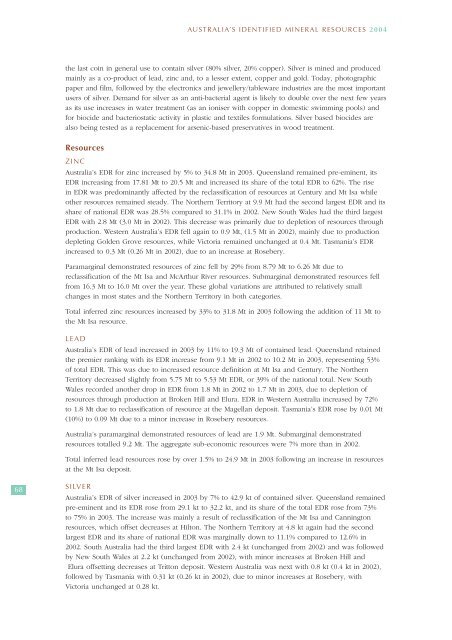australia's identified mineral resources 2004 - Geoscience Australia
australia's identified mineral resources 2004 - Geoscience Australia
australia's identified mineral resources 2004 - Geoscience Australia
You also want an ePaper? Increase the reach of your titles
YUMPU automatically turns print PDFs into web optimized ePapers that Google loves.
AUSTRALIA’S IDENTIFIED MINERAL RESOURCES <strong>2004</strong><br />
the last coin in general use to contain silver (80% silver, 20% copper). Silver is mined and produced<br />
mainly as a co-product of lead, zinc and, to a lesser extent, copper and gold. Today, photographic<br />
paper and film, followed by the electronics and jewellery/tableware industries are the most important<br />
users of silver. Demand for silver as an anti-bacterial agent is likely to double over the next few years<br />
as its use increases in water treatment (as an ioniser with copper in domestic swimming pools) and<br />
for biocide and bacteriostatic activity in plastic and textiles formulations. Silver based biocides are<br />
also being tested as a replacement for arsenic-based preservatives in wood treatment.<br />
Resources<br />
ZINC<br />
<strong>Australia</strong>’s EDR for zinc increased by 5% to 34.8 Mt in 2003. Queensland remained pre-eminent, its<br />
EDR increasing from 17.81 Mt to 20.5 Mt and increased its share of the total EDR to 62%. The rise<br />
in EDR was predominantly affected by the reclassification of <strong>resources</strong> at Century and Mt Isa while<br />
other <strong>resources</strong> remained steady. The Northern Territory at 9.9 Mt had the second largest EDR and its<br />
share of national EDR was 28.5% compared to 31.1% in 2002. New South Wales had the third largest<br />
EDR with 2.8 Mt (3.0 Mt in 2002). This decrease was primarily due to depletion of <strong>resources</strong> through<br />
production. Western <strong>Australia</strong>’s EDR fell again to 0.9 Mt, (1.5 Mt in 2002), mainly due to production<br />
depleting Golden Grove <strong>resources</strong>, while Victoria remained unchanged at 0.4 Mt. Tasmania’s EDR<br />
increased to 0.3 Mt (0.26 Mt in 2002), due to an increase at Rosebery.<br />
Paramarginal demonstrated <strong>resources</strong> of zinc fell by 29% from 8.79 Mt to 6.26 Mt due to<br />
reclassification of the Mt Isa and McArthur River <strong>resources</strong>. Submarginal demonstrated <strong>resources</strong> fell<br />
from 16.3 Mt to 16.0 Mt over the year. These global variations are attributed to relatively small<br />
changes in most states and the Northern Territory in both categories.<br />
Total inferred zinc <strong>resources</strong> increased by 33% to 31.8 Mt in 2003 following the addition of 11 Mt to<br />
the Mt Isa resource.<br />
LEAD<br />
<strong>Australia</strong>’s EDR of lead increased in 2003 by 11% to 19.3 Mt of contained lead. Queensland retained<br />
the premier ranking with its EDR increase from 9.1 Mt in 2002 to 10.2 Mt in 2003, representing 53%<br />
of total EDR. This was due to increased resource definition at Mt Isa and Century. The Northern<br />
Territory decreased slightly from 5.75 Mt to 5.53 Mt EDR, or 39% of the national total. New South<br />
Wales recorded another drop in EDR from 1.8 Mt in 2002 to 1.7 Mt in 2003, due to depletion of<br />
<strong>resources</strong> through production at Broken Hill and Elura. EDR in Western <strong>Australia</strong> increased by 72%<br />
to 1.8 Mt due to reclassification of resource at the Magellan deposit. Tasmania’s EDR rose by 0.01 Mt<br />
(10%) to 0.09 Mt due to a minor increase in Rosebery <strong>resources</strong>.<br />
<strong>Australia</strong>’s paramarginal demonstrated <strong>resources</strong> of lead are 1.9 Mt. Submarginal demonstrated<br />
<strong>resources</strong> totalled 9.2 Mt. The aggregate sub-economic <strong>resources</strong> were 7% more than in 2002.<br />
Total inferred lead <strong>resources</strong> rose by over 1.5% to 24.9 Mt in 2003 following an increase in <strong>resources</strong><br />
at the Mt Isa deposit.<br />
68<br />
SILVER<br />
<strong>Australia</strong>’s EDR of silver increased in 2003 by 7% to 42.9 kt of contained silver. Queensland remained<br />
pre-eminent and its EDR rose from 29.1 kt to 32.2 kt, and its share of the total EDR rose from 73%<br />
to 75% in 2003. The increase was mainly a result of reclassification of the Mt Isa and Cannington<br />
<strong>resources</strong>, which offset decreases at Hilton. The Northern Territory at 4.8 kt again had the second<br />
largest EDR and its share of national EDR was marginally down to 11.1% compared to 12.6% in<br />
2002. South <strong>Australia</strong> had the third largest EDR with 2.4 kt (unchanged from 2002) and was followed<br />
by New South Wales at 2.2 kt (unchanged from 2002), with minor increases at Broken Hill and<br />
Elura offsetting decreases at Tritton deposit. Western <strong>Australia</strong> was next with 0.8 kt (0.4 kt in 2002),<br />
followed by Tasmania with 0.31 kt (0.26 kt in 2002), due to minor increases at Rosebery, with<br />
Victoria unchanged at 0.28 kt.

















